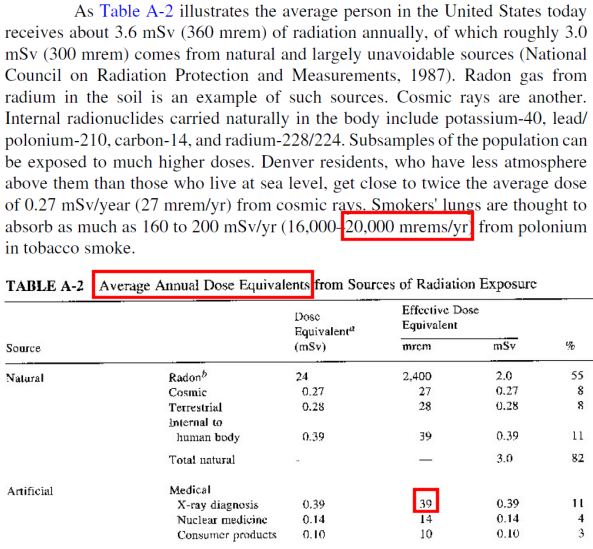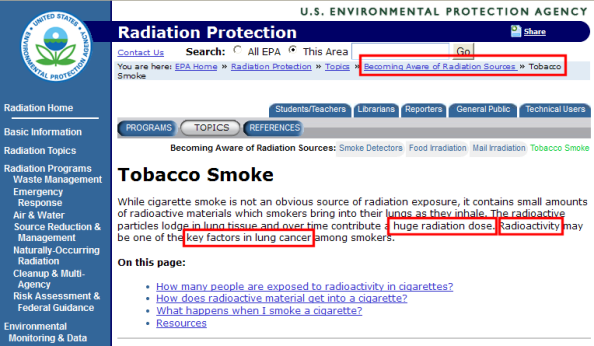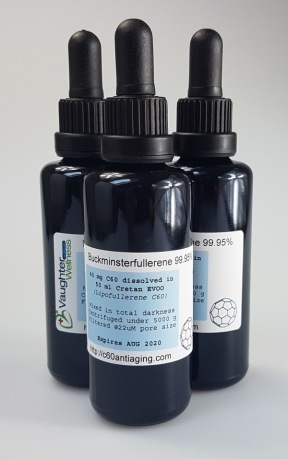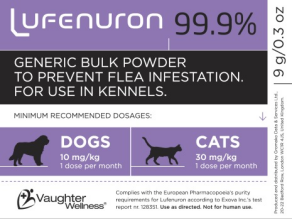
Radioactive tobacco causes smokers' lung cancer
 The second biggest cause of lung cancer in the Western world is Radon gas. There are approximately 21,000 deaths per year in the USA due to Radon-induced lung cancers. The reason why Radon gas causes cancer is mainly the fact that its decay chain produces alpha particles, and alpha particles are by far the most potent cancer-causing radiation. Alpha radiation is much more likely to cause genetic damage than neutron-, beta- or gamma radiation. The reason is that alpha particles are massive and, like a cannonball through a carnival can easily disintegrate thousands of DNA molecules in their path. There are even ways for alpha particles to cause cancer without directly damaging DNA.
The second biggest cause of lung cancer in the Western world is Radon gas. There are approximately 21,000 deaths per year in the USA due to Radon-induced lung cancers. The reason why Radon gas causes cancer is mainly the fact that its decay chain produces alpha particles, and alpha particles are by far the most potent cancer-causing radiation. Alpha radiation is much more likely to cause genetic damage than neutron-, beta- or gamma radiation. The reason is that alpha particles are massive and, like a cannonball through a carnival can easily disintegrate thousands of DNA molecules in their path. There are even ways for alpha particles to cause cancer without directly damaging DNA.
Radon is a distant second when it comes to lung cancer though. It is merely responsible for a single-digit percentage of this horrible disease. By far the main cause of lung cancer is smoking, the cause of nearly all lung tumors. This is hardly controversial, but exactly how the bulk of these smoking-related tumors are being caused is still up for debate. There are scientists who suspect that smokers would hardly ever get cancer if they wouldn't inhale Polonium 210 vapor. Polonium 210, the notorious radioactive poison with which the KGB allegedly killed Alexander Litvinenko. Why would you want to get that stuff into your lungs and more importantly, why would the tobacco industry put it into cigarettes? Because they actively do that. They put the radioactive Polonium 210 into their cigarettes. On purpose. To make an extra buck. And they admitted this.
Tiny doses of Polonium 210 can cause cancer
Every time we write an article such as this, we'll have to make very sure we won't be accused of promulgating "conspiracy theories". Let start by proving that Polonium 210 occurs in tobacco smoke. In 1999, the International Agency for Research on Cancer was quoted by Physicians for a Smoke-Free Canada that tobacco smoke contains Polonium 210, and that this substance is carcinogenic to humans. In 1995, the book "Isotopes for Medicine and the Life Sciences" by the Institute of Medicine / National Academies Press published the following information:

The table shows that smokers' lungs are exposed to 20000 / 39 = 512 times more radioactivity than what they on average get from medical X-Rays. When you get a chest X-Ray, the operator of the machine stands behind a thick lead screen to avoid them getting cancer from frequent exposure to stray rays. Because when the operator would not be shielded, she would receive a bit of that X-Ray radiation as well. Hundreds of equivalent chest X-rays a year, every year can't be good for cancer prevention. Even if you're a smoker, would you willingly subject yourself to twenty thousand chest X-rays? That's what you may have been doing, and noone told you that the radioactivity has been deliberately introduced. Because it makes the cigarettes a little bit cheaper to produce. Radioactivity in tobacco is ever-increasing. The Fukushima and Chernobyl disaster contributed to an increase in radioactive contaminants in tobacco, to give but an example.
Philip Morris' radioactive fags saved them cash
Polonium 210 deliberately introduced to the tobacco plant to increase profits? Yes the, growers did. Tobacco production is big business, a business run just like any other. Big Tobacco has a choice of fertilizers. They decided to use the cheapest fertilizer: Radon-riddled phosphate fertilizer. It's radioactive, but it's cheap! The plant absorbs the Radon, which decays to Lead 210 and Polonium 210 and some other nasty isotopes. The tobacco industry knew about all this and the resulting risk of cancer, but covered it up. Also, they decided not to remove the radioactive pollution they encouraged the farmers to introduce. Letting the farmers wash the leaves after harvest or switching to ammonium- instead of calcium phosphate would be a simple method to remove the radioactivity, but it would diminish profits. Conspiracy? You bet! Read the details of this conspiracy in Scientific American. The scientific publication "Polonium and Lung Cancer" is one of many studies relating to the scandal.
The US government covered Philip Morris' ass
The conspiracy extends to the US government. US Surgeon General Charles Everett Koop is alleged to have said in 1990 on US national TV that tobacco radiation is probably responsible for 90% of tobacco-related cancer. However, we could not find any reference to this in any reports commisioned by him or by the US government in any tobacco-risk assesment publication - ever. There is no evidence that he ever said that. And we searched through 1500 pages. The 2010 792-page report entitled "How Tobacco Smoke Causes Disease" by the Surgeon General of the United States contains ZERO references to radioactivity from cigarette smoke as a contributing cause to lung cancer. In light of the many studies done, this can only be a deliberate omission. And what about the 713-page report commissioned by Charles Everett Koop, entitled "Reducing the Health Consequences of Smoking" published in 1989, one year before his alleged TV statement? Again, we searched for the word "radiation". ZERO mention of it in relation to it being present in tobacco. Everett Koop's alleged statement can not be proven and has, seen the glaring omission in his own report from a year prior, most likely never been made. 1505 pages of in-depth science on exactly how tobacco smoke causes cancer. And no mention of radioactivity anywhere. We wonder why. Could it be that the US government knew about the danger of radioactive radiation in cigarettes but they did not want to draw attention to their thousands of nuclear tests, of which a large percentage were done above-ground? Cancer figures rose sharply ever since they did those tests.
EPA: "Cigarettes deliver a huge radiation dose"
Surely, such a big conspiracy can't be covered up indefinitely by all people in all relevant US government agencies? Correct. The US Surgeon General refuses to touch upon this subject. But the Environmental Protection Agency EPA talks about "huge radiation doses" from cigarette smoke. And that it may be a "key factor in lung cancer":

Radioactive cigarette smoke causes cancer
When you smoke a cigarette, the Polonium 210 evaporates and partially gets lodged in the airway's branches, and partially gets absorbed by the lungs, bringing the Po-210 into the blood stream. This alpha-emitter then lodges in various organs, where it often causes cancer. There is a wealth of research available that proves this. Experiments on animals have conclusively shown that the Polonium 201 in cigarettes causes cancer. In 1986, this study appeared: Lung cancer: is the increasing incidence due to radioactive polonium in cigarettes? It is old news. In 2006, the New York Times had an article "Puffing on Polonium". Do not think this is all overblown. Do not think this is mere scaremongering. The scientific findings are clear and they are severe. They are confirmed worldwide. Tobacco is so radioactive that workers in tobacco fields are exposed to increased radioactivity: "The higher concentration of uranium, thorium, potassium and radon exhalation rates in tobacco samples enhances the radiation dose received by the worker working in tobacco fields and the smokers are at a higher risk of lung cancer."
If you are interested in all details of the radioactive tobacco story, you should read "The Polonium Brief - A hidden History of Cancer, Radiation and the Tobacco Industry" by Brianna Rego. It is a fascinating piece of detective work, meticulously documenting the history of tobacco's Polonium 210 issue and its health consequences for smokers - also those of second-hand smoke. Not all cigarettes are equally radioactive. It depends where the tobacco is grown. But even better is to stop smoking.


 Dermaneedling for Alopecia
Dermaneedling for Alopecia What you need for dermaneedling your skin issues
What you need for dermaneedling your skin issues See how competing devices cause skin microtearing
See how competing devices cause skin microtearing Copper peptides for dermaneedling
Copper peptides for dermaneedling Dermarolling explained
Dermarolling explained How dermaneedling works
How dermaneedling works
 Psychological aspects of stretchmarks and the beauty cult
Psychological aspects of stretchmarks and the beauty cult Dermaneedling side effects?
Dermaneedling side effects? Stretchmarks: Single needle before and after
Stretchmarks: Single needle before and after
 What to do about Cellulite?
What to do about Cellulite? Dermaneelding: Hype vs. reaslistic results
Dermaneelding: Hype vs. reaslistic results Progress pics: Acne scars, stretchmarks, pigmentation
Progress pics: Acne scars, stretchmarks, pigmentation SkinPen review: Deceptive advertising!
SkinPen review: Deceptive advertising!





